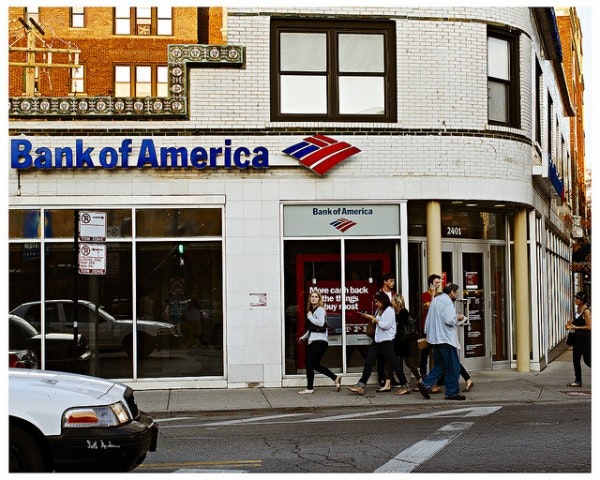We are not that far removed from the near total collapse of the financial and banking systems in the United States, and the rest of the world as well. In 2008, as the banking system found itself holding a massive amount of poorly collateralized loans on their books, with no hope of recovering the principle, the prospects of having to write down these losses against their capital reserves presented what most believed to be a potentially catastrophic situation, capable of bringing the global financial system to its knees.

The federal government of the United States injected enough liquidity and monetary support to the overall economy in general, and the banks in particular, to avert the potential crisis to a great extent.
Now that we are a few years away from that event, and the Federal Reserve is still flooding the system with cheap cash and holding short term interest rates at exceptionally low levels, it is time for prudent investors to take advantage of the opportunity to produce safe, consistent returns from the recovery of the banking industry over the next several years. While the industry is currently rife with values, I selected four “household names” to review for investment consideration.
Bank of America Corp (NYSE:BAC), Citigroup Inc. (NYSE:C), JPMorgan Chase & Co. (NYSE:JPM), and Wells Fargo & Co (NYSE:WFC) are four names that are probably readily recognized by almost anyone in America today and most people in the developed world. At today’s valuations, I believe all four of these to be worthy of careful consideration as potential investments.
Bank of America could explode higher
With a price to book ratio of only 63%, Bank of America Corp (NYSE:BAC) would have to rise over 50% to simply be trading at par with the liquidation value of its assets. Given that we are not far removed from the 2008/2009 meltdown, it is unlikely that the book value is overstated at this time.
Historically, well run banks can trade for between 1.3 and 1.5 times book value, and still be considered fairly priced. To reach that level of valuation, Bank of America Corp (NYSE:BAC) would have to double in price. Its current price produces a forward P/E of 9.68, which is right in line with its 5-year projected earnings growth rate of 9.8%. It also has a dividend yield of 0.31%.
If a PEG of 1 plus the dividend rate is used as an estimate of value, then Bank of America Corp (NYSE:BAC) should have the ability to provide an annualized return of approximately 10%, while investors await a return to a more reasonable price to book valuation to deliver an exceptional capital gain.
Citigroup is a bargain
Citigroup Inc. (NYSE:C) is another major bank trading below book value at a 74% ratio. This stock would have to rise 35% in order to reach liquidation value, and could double without being considered expensive by industry standards. In addition, while it has a dividend yield of only 0.09%, its payout ratio is a minuscule 2%, leaving a great deal of room for increases.
With a 5-year annual earnings growth projection of 10.8% and a current forward P/E ratio of 8.52, Citigroup Inc. (NYSE:C) appears to be well positioned to deliver 10% annualized returns, while patient investors wait for the capital gains to come from an improved price to book ratio.
JPMorgan Chase for solid returns with potential growth
JPMorgan Chase, while not as undervalued to book as the first two banks discussed, is still trading at only 96% of book, leaving room for a 30%-50% capital gain should it rise to a 1.3 to 1.5 multiple. It has a 5-year projected earnings growth rate of 7.1% plus a 2.44% dividend rate, that could realistically produce annualized returns of 9.5% with the potential addition of attractive capital gains, should the price to book value increase to 1.5 times.
This bank is fairly valued today and is poised to deliver steady returns to investors over time, and still retains the potential for excellent capital gains from an increase in the price to book valuation. This bank also holds a fairly low price to cash flow multiple of 7.3 to 1, which is significantly below the industry average of 11.7. This discount of cash flow to the industry would require a 60% increase in the share price of JPMorgan to price it equal with the industry average.
Wells Fargo — a household name endorsed by a household name
Wells Fargo is a household name known around the world. As it happens, another household name Warren Buffett, through Berkshire Hathaway Inc. (NYSE:BRK.A), is the largest shareholder in the bank.
If anyone ever needs a little extra assurance while evaluating a solid, well-run business, seeing Berkshire Hathaway as the largest shareholder should assuage any concerns. While Wells Fargo is more expensive than the other three banks discussed here, it is still priced to deliver reasonable returns. With a projected 5-year earnings growth rate of 10.10% and a dividend yield of 2.67%, this stock could reasonably deliver 12%-13% annualized over the next five years.
A plan for Profit
In the interest of spreading risk, prudent investors may wish to allocate 25% of their capital to the banking sector into each of the bank stocks discussed here; thus taking advantage of the undervalued stocks and adding the security of the larger, more stable ones.
The article Take the Profits from These Banks to Your Bank originally appeared on Fool.com and is written by Ken McGaha.
Copyright © 1995 – 2013 The Motley Fool, LLC. All rights reserved. The Motley Fool has a disclosure policy.